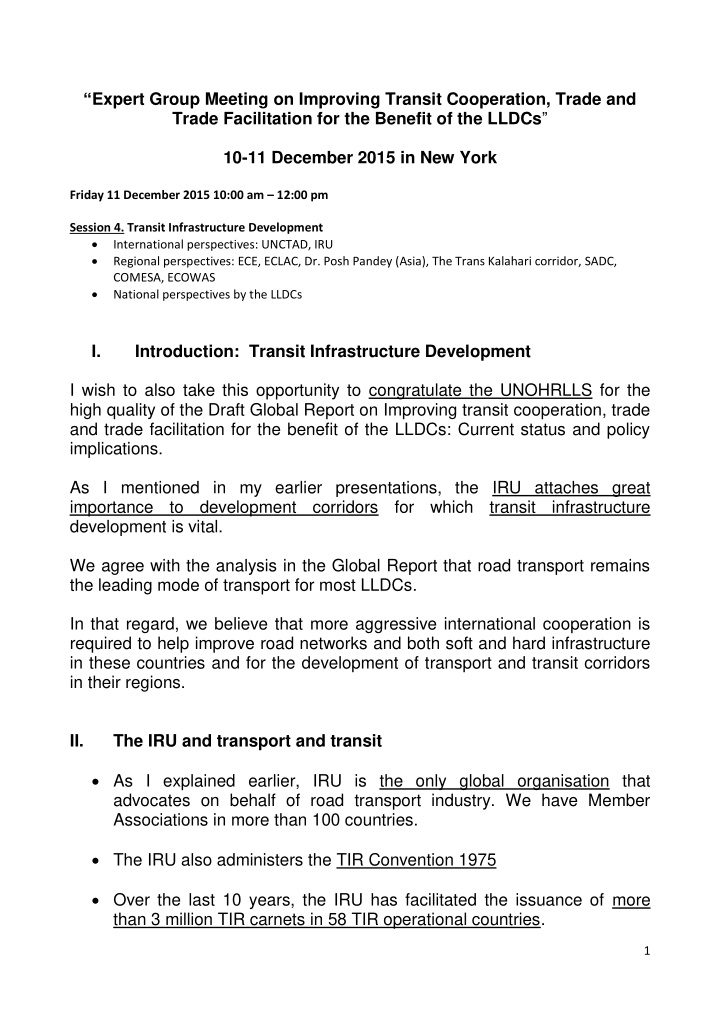



“ Expert Group Meeting on Improving Transit Cooperation, Trade and Trade Facilitation for the Benefit of the LLDCs ” 10-11 December 2015 in New York Friday 11 December 2015 10:00 am – 12:00 pm Session 4. Transit Infrastructure Development International perspectives: UNCTAD, IRU Regional perspectives: ECE, ECLAC, Dr. Posh Pandey (Asia), The Trans Kalahari corridor, SADC, COMESA, ECOWAS National perspectives by the LLDCs I. Introduction: Transit Infrastructure Development I wish to also take this opportunity to congratulate the UNOHRLLS for the high quality of the Draft Global Report on Improving transit cooperation, trade and trade facilitation for the benefit of the LLDCs: Current status and policy implications. As I mentioned in my earlier presentations, the IRU attaches great importance to development corridors for which transit infrastructure development is vital. We agree with the analysis in the Global Report that road transport remains the leading mode of transport for most LLDCs. In that regard, we believe that more aggressive international cooperation is required to help improve road networks and both soft and hard infrastructure in these countries and for the development of transport and transit corridors in their regions. II. The IRU and transport and transit As I explained earlier, IRU is the only global organisation that advocates on behalf of road transport industry. We have Member Associations in more than 100 countries. The IRU also administers the TIR Convention 1975 Over the last 10 years, the IRU has facilitated the issuance of more than 3 million TIR carnets in 58 TIR operational countries. 1
While our core focus is on TIR and trade facilitation, we have first-hand experience that soft infrastructure to facilitate trade is not effective without secure, resilient and reliable hard transport infrastructure including, but not limited to roads. III. Transport and Transit: The International Perspective Three priorities: (1) MHI (2) The need for a regional approach to financing transport infrastructure More PPP to formulate “blended finance” (3) solutions (1) The Model Highway Initiative (MHI) Transport and transit corridors facilitate trade, and create development corridors that link regional and global markets that stimulate economic activity at and around border crossings and along major highways, and create backward linkages with cities and more remote regions. The IRU has extensive experience in working with countries to develop transport and transit corridors through the implementation of the Model Highway Initiative – an exemplary road section with modern, safe and convenient ancillary infrastructure. The MHI also promotes regional integration (2) The regional approach to financing transport infrastructure Until now, the traditional bilateral approach to financing has not resulted in the introduction of sufficient levels of infrastructure to facilitate regional and global trade and to promote economic growth. As called for by the Vienna Programme of Action, new and more innovative approaches to financing are required. Multilateral and regional development banks and donors could consider alternative ways to structure financing in order to ensure widespread benefits at the regional level. 2
(3) Blended Financing as an innovative approach to finance transport infrastructure The Addis Ababa Action Agenda adopted in July 2015 underscored the importance of public private partnerships and the potential of new investment vehicles such as blended finance mechanisms which combine concessional public finance with non-concessional private finance and expertise from both the public and private sector to finance transport infrastructure. Blended finance instruments can lower investment risks and create incentives for private sector finance. Such PPP schemes combine the strengths of partners – by mobilising private financing led by constructive regional, national and sub-national government policies and priorities for sustainable development. I thank you for your attention. 3
Recommend
More recommend